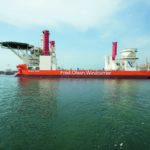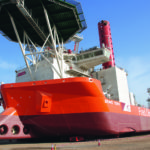The year 2012 will see a purposeful variety of wind farm installation and support vessels launched that demonstrate the lessons already learnt in the rapidly maturing industry.
The first wind farm service vessels consisted of an assortment of fishing vessels and catamarans co-opted to support turbine[ds_preview] installation vessels and barges that themselves were designed for the offshore oil and gas industry. The first purpose-built wind farm installation vessel, »Mayflower Resolution«, today »MPI Resolution«, was launched in 2003 and this vessel marked a turning point as the industry clearly differentiated itself from other offshore endeavours. Now this pioneer vessel is being supplemented by a new generation of larger capacity vessels which are built to meet increasing demand and to reflect the growing experience of the industry as well as the changing nature of new offshore wind farms.
A new generation installation vessel, »Brave Tern«, built by Lamprell for Fred Olsen Windcarrier, will be completed in Spring 2012 and this self-propelled, self-elevating vessel has an 800 t crane, significantly larger than the original 300 t crane on »MPI Resolution« which has since been upgraded to 600 t. The crane on »Brave Tern« wraps around the stern port jack-up leg to make room for a 3,200 m2 deck space. This means more equipment can be carried and therefore fewer trips to shore are needed during wind farm construction. The vessel is designed to carry a range of equipment including foundations, columns, generator houses and blades which are then lifted into position. In general, the choice of crane capacity is linked to the intended operational profile of the vessel based on the economics associated with the development concept of an individual wind farm. For example, it is inefficient to use a vessel with 1,000 t or more capacity if it is only needed for maintenance tasks or installing turbine parts above sea level.
»Brave Tern« was classed by Det Norske Veritas (DNV) as was »MPI Resolution«. The lifting operations undertaken by these vessels are considered to be offshore lifts where additional dynamic effects due to the sea must be considered. As class society, DNV was responsible for ensuring that hull stresses and the interaction between crane and jack-up legs were designed within safe margins and in accordance with DNV’s rules for wind turbine installation units.
The high capacity crane on »Brave Tern« allows for greater operational flexibility and, although this vessel is currently amongst the largest in service, DNV sees this as typical of the new vessels entering the industry. Some operators are finding that the safest approach is to do as much assembly and preparation work as possible onshore so possibly the transportation and installation of complete units in the future will be seen.
The installation vessel »Aeolus«, commissioned by Van Oord from German shipbuilder J.J. Sietas, is another example of how large crane capacity is desired for new installation vessels. »Aeolus«, expected to be delivered at the end of 2012, will have a hoisting capacity of 900 t and a transportation capacity of 6,500 t. Another case is »MPI Discovery« and her sister »MPI Adventure«, built for MPI Offshore Limited by the Chinese Cosco Qidong shipyard, which both have a 1,000 t capacity main crane plus a 50 t auxiliary crane.
There are currently 25 installation vessels in operation globally and another eleven are under construction. DNV provides consulting services that include analysis of cost benefits and risks for the establishment of offshore wind farms, and the approach taken can influence installation vessel design, crane capacity and crane location. Most of the new vessels have the crane arranged around the jack-up legs as this allows a larger working area on deck – but new ideas are coming. A moveable crane could allow for more efficient operation by providing greater flexibility in picking-up cargo on the deck of the vessel.
»There are currently 25 installation vessels in operation and eleven under construction«
Where a jack-up vessel used in the oil and gas industry may install itself a few times a year, it is typical for wind farm installation vessels to do so on nearly a daily basis as they move from one turbine to the next. Rack and pinion or hydraulic jacking systems combined with monopile legs are seen as a standard for most installation vessels, but lighter, more expensive truss legs are selected for larger vessels that are planned for operation in deeper waters.
Manoeuvrability is enhanced in latest generation vessels through the installation of dynamic positioning systems and the positioning accuracy that this makes possible offers the additional benefit of reducing the risk of anchor damage to power cables that have already been laid on the sea floor. This is currently one of the greatest costs impacting the installation of new wind farms.
It is desirable that installation vessels are capable of rapid transits between shore and wind farms for greater efficiency and it is also necessary to move rapidly in adverse weather. DNV’s »GeniE« design and analysis software is suited to the design of the unique hulls that arise from this desire for high speed as well as maximum working deck space. »To operate with optimal efficiency, the vessels are designed for speeds of around 10–12 knots. This requires a ship-shaped
hull which allows for higher transit speed and better seagoing properties than conventional jack-ups«, says DNV senior engineer Mathias Sørhaug. »With four or six legs – as opposed to three for jack-ups – the pre-load condition causes extensive global bending moments and shear forces in the hull structure that have to be considered during the structural design of the hull. Thus the hull is modelled using shell and beam elements to pick up both global and local responses. A final capacity check is performed using the Puls yield and buckling calculations that are integrated in ›GeniE‹.« The benefit of the software is that one common model can run all the required wave load and structural analyses, explains Sørhaug: »The integration of the wave load analysis and structural analysis saves a lot of effort compared to other tools where data and results must be transferred between different programs and models. It is not only a great timesaver, but also keeps the user in control of the analysis and limits potential error sources,« he says.
DNV released class notations for installation vessels in 2009 and this was followed in 2010 with notations for the small wind farm service vessels that deliver crew and equipment during both construction and operation of wind farms. Previously shipyards and operators either needed to apply codes that were not designed with these vessels in mind, like the High Speed Craft Code, or they needed to apply domestic standards which limit the flexibility of the vessels.
In consultation with European flag states, shipyards and shipowners, DNV has developed rules that support the safe and reliable operation of craft servicing current and future planned offshore wind farms. The need to control costs has been a very important driver in the development of the rules as class aims to add value to the newbuilding process and during vessel operations but, in the end, the need for safety must prevail. Like their installation counterparts, these service vessels may increase in size as wind farms are established further from shore. This may bring up other needs, which already exist in the offshore oil and gas industry, such as to have accommodation vessels for workers that remain on-site.
Sönke Pohl




















